208
TRANSVERSE MASS
If
one
imagines
all electrostatic force
components
to be multiplied
everywhere by
n2,
then,
as can
be
seen
easily from
the
above
equations
of
motion,
the electron will
move
according
to
the
equations
x
=
q1(nt)
,
y =
q2(nt)
,
z
=
q3(nt)
.
From
this it follows that
a
proportional
change
of the field is
accompanied
by
a
change
of the electrons'
velocity
but
not
of
their trajectory.
A
change
of trajectory
evidently
is
produced
by
a
proportional
change
of
the field
only at
electron velocities
at
which
the ratio
of transverse to
longitudinal
mass
is
noticeably
different
from unity.
If the electrostatic
field is
chosen such
that the cathode
rays
travel
a
strongly
curved
path,
then
even
small differences
between
the
transverse and
the
longitudinal
mass
will
have
an
observable effect
on
the
trajectory.
The
accompanying
sketch
shows
an
arrangement
by
which
the ratio of the
transverse to
the
longtudinal
mass
of
the
electron
could
be
determined
on
the basis of the principle indicated.
The
cathode
rays
attain
their
velocity between
the
grounded
cathode
K
and
the
anode
A,
which
is attached
to
the
positive
terminal of the
current
source
M
and which
serves
at
the
same
time
as
a
shutter,
and
are
then
introduced,
via
a
thin tube
t
connected with
A,
into the
space
between
the metal
cylinders
R1
and
R2.
R1
is
grounded,
R2
is
conductively
connected with
t,
i.e.,
with the
positive
pole
of the
current
source,
whose negative pole
is
grounded.
